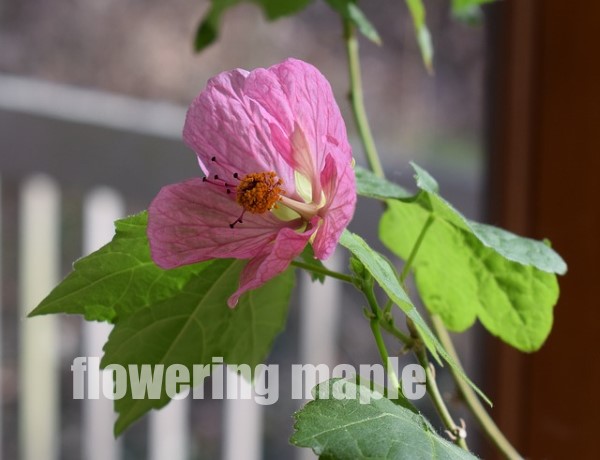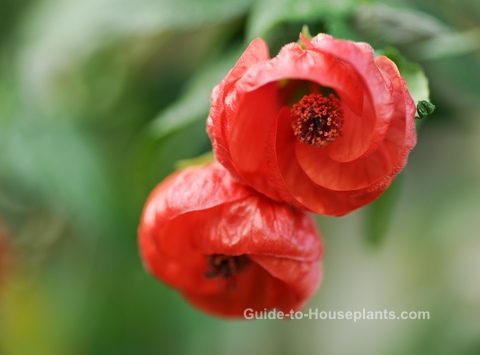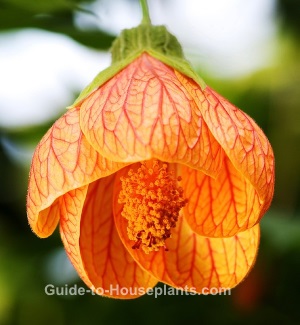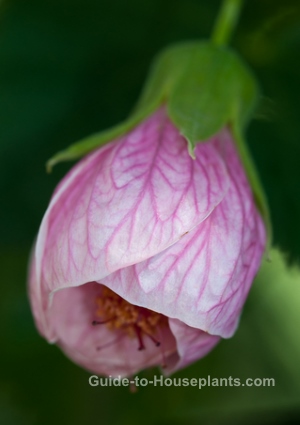Flowering Maple Plant Care
Flowering maple flourishes when given the same conditions as its native tropical habitat. Bright light and warmth will make Abutilon thrive in your home -- and flower most of the year.

Get to Know Flowering Maple
Maple leaf-shaped foliage lends one of its common names. Sometimes called Chinese lantern plants because of the shape of the drooping papery flowers.
You can expect the big, bell-shaped flowers of red, pink, orange, yellow or peach to cover flowering maples from spring through fall.
Abutilon is a member of the Malvaceae family, along with mallows and hollyhocks. This genus includes more than 100 beautiful flowering shrubs. In its native habitat, it can grow up to 10 ft (3 m) tall. Indoors, it's a good idea to keep it around 2-3 ft (60-90 cm).
Flowering maple responds well to pruning, so don't be afraid to cut it back harshly in spring -- removing up to a third of the plant. Prune back in the spring, before the most vigorous growth begins. Pruning Abutilon regularly will keep the plant small and prevent it from becoming leggy. Also, pinch off growing tips to promote branching.

Flowering maples have long been popular houseplants. In fact, they'll thrive in pots as long as you can meet their needs for sunlight, warmth and moisture.
Water thoroughly. Uneven watering can result in dry pockets in the soil. Dry roots will quickly cause the plant to wilt, and it may drop its leaves and flowers. Always use a pot with a drainage hole to prevent soggy soil, which can lead to root rot.
Shed some light. Flowering maple needs plenty of light to bloom. Put it in front of a sunny window. You can move it outdoors for the warm months, if you want. Just be sure to shade it from hot, midday sun.
Repot in spring, when you see new growth. This plant blooms best when slightly pot-bound, so move it to a pot 1 size larger only when necessary.
Watch for bugs. Aphids may attack new growth on this plant, leaving a sticky residue on leaves. Another pest to watch for is spider mites. Although difficult to see, you'll notice their fine webbing between leaves and stems.

Abutilon Hybrids and Cultivars
You can buy Flowering Maple plants in garden centers and online flower delivery sites. You have lots of beautiful varieties to choose from. 'Red Glory' is a prolific bloomer...'Pink Lady' has bright-pink flowers marked with deep-pink veins...'Apricot Glow' has golden flowers.
Some varieties have yellow mottled foliage, such as A. pictum 'Thompsonii' and 'Gold Dust'.

Flowering Maple Plant Care Tips
Origin: Brazil
Height: Up to 10 ft (3 m) if not pruned back. Prune regularly to keep the plant at a maximum of 3 ft (90 cm). Tall plants will need staking.
Light: Bright light to full sun. Shade from hot, direct midday sun which can scorch its leaves. Plants that don't bloom aren't getting enough sun. Put your plant in the brightest window possible.
Water: Water thoroughly, then allow the top inch of soil to dry out between waterings. Use a pot with drainage holes, and remember to empty the drainage tray after watering to prevent soggy soil which can lead to root rot. If flowering maple plant gets too dry, it will quickly wilt.
Humidity: Moderate, around 40-50% relative humidity. Indoor humidity can drop drastically during the winter months. It's a good idea to use a humidity monitor near your plant rather than guess. The most efficient way to boost moisture for houseplants is to use a cool-mist room humidifier.
Temperature: Average to warm (65-80°F/18-27°C). These tropical natives don't like the cold at all. If you move your plant outdoors for the summer, bring it back inside if the temperature dips below 55°F/13°C at night. Cold temps may cause flowering maple to drop its leaves and go dormant for the winter.
Soil: Use a peat moss-based potting mix.
Fertilizer: Feed every 2 weeks spring through fall with a high-phosphorus water-soluble fertilizer diluted by half.
Propagation: Soft wood cuttings work best for propagating flowering maple hybrids. Use sharp, sterilized pruners to take 4 inch (10 cm) stem tip cuttings in spring. Cut off the leaves from the bottom half of the stem tip cuttings. Then, dip the cut ends in rooting powder before planting the cuttings in moist peat-based potting mix. Don't overpot -- a 3- or 4-inch pot with drainage holes will do. Keep the potting mix lightly moist. Use a heat mat to ensure the plants are kept at a consistent 70°F/21°C temperature.


